
Abatia is a genus of about ten species of Central and South American trees in the willow family Salicaceae. Previously, it was treated in the family Flacourtiaceae, or tribe Abatieae of the family Passifloraceae or Samydaceae by G. Bentham & J.D. Hooker and Hutchinson.
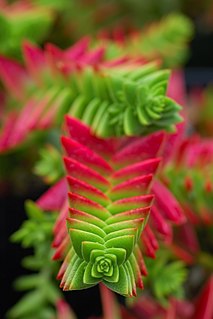
Crassula is a genus of succulent plants containing about 200 accepted species, including the popular jade plant. They are members of the stonecrop family (Crassulaceae) and are native to many parts of the globe, but cultivated varieties originate almost exclusively from species from the Eastern Cape of South Africa.
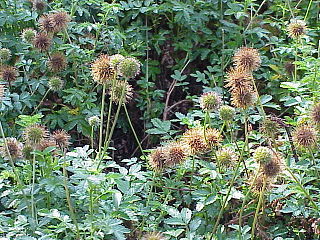
Acaena is a genus of about 60 species of mainly evergreen, creeping herbaceous perennial plants and subshrubs in the family Rosaceae, native mainly to the Southern Hemisphere, notably New Zealand, Australia and South America, but with a few species extending into the Northern Hemisphere, north to Hawaii and California.

Azorella is a genus of flowering plants in the family Apiaceae, native to South America, New Zealand, southeastern Australia, and the islands of the Southern Ocean.
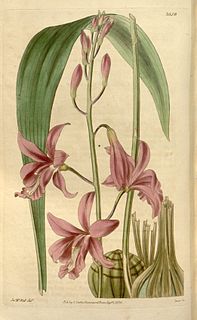
Bletia is a genus of about 30 species of orchids, almost all of which are terrestrial; some are occasionally lithophytic or epiphytic. It is named after Spanish botanist and pharmacist Don Luis Blet. The genus is widespread across Florida, Mexico, Central America, the West Indies, and South America as far south as Argentina.

Calandrinia are a large genus of flowering plants known as purslanes and redmaids. It includes over 100 species of annual and perennial herbs which bear colorful flowers in shades of red to purple and white. Plants of this genus are native to Australia, western South America, Central America, and western North America. Some species have been introduced to parts of New Zealand, southern Africa, Asia, and Europe.
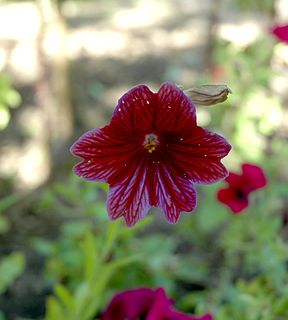
Salpiglossis is a genus of flowering plants belonging to the subfamily Cestroideae of family Solanaceae. It is closely related to the genus Reyesia, with which it makes up the tribe Salpiglossideae. Species in the genus Salpiglossis are found in Mexico, Argentina and Chile.

Hipólito Ruiz López, or Hipólito Ruiz, was a Spanish botanist known for researching the floras of Peru and Chile during an expedition under Carlos III from 1777 to 1788. During the reign of Carlos III, three major botanical expeditions were sent to the New World; Ruiz and José Antonio Pavón Jiménez were the botanists for the first of these expeditions, to Peru and Chile.

Galinsoga is a genus of flowering plants in the family Asteraceae. It is native to North and South America and the West Indies, and naturalized in Europe, Asia, Africa, and Australia.

José Antonio Pavón Jiménez or José Antonio Pavón was a Spanish botanist known for researching the flora of Peru and Chile.

Crassula helmsii, known as swamp stonecrop or New Zealand pigmyweed, is an aquatic or semiterrestrial species of succulent plant in the family Crassulaceae. Originally found in Australia and New Zealand, it has been introduced around the world. In the United Kingdom, this plant is one of five introduced invasive aquatic plants which were banned from sale from April 2014. This is the first ban of its kind in the country. It is on the Global Register of Introduced and Invasive Species of eleven countries.
Hypagophytum is a genus of plants in the family Crassulaceae. It includes only the species Hypagophytum abyssinicum, endemic to Eritrea and Ethiopia.

Galinsoga quadriradiata is a species of flowering plant in the family Asteraceae which is known by several common names, including shaggy soldier, Peruvian daisy, hairy galinsoga. Its native home is apparently central Mexico, although it has become naturalized in many other places.

Sinocrassula is a genus of succulent, subtropical plants of the family Crassulaceae.
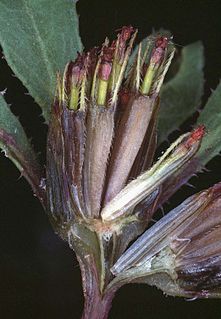
Bidens connata , the purplestem beggarticks or London bur-marigold, is a species of flowering plant in the daisy family. It is widespread across much of Eurasia, North Africa, and North America, and naturalized in Australia and on certain Pacific Islands.

Pachyphytum hookeri is a species of plant in the genus Pachyphytum of the family Crassulaceae.
Crassula alata is a herb in the family Crassulaceae. It is native to the Mediterranean basin and is now also found in southern Australia and New Zealand. The succulent annual herb typically grows to a height of 5 centimetres (2.0 in). It produces white flowers in the spring time between August and October in the southern hemisphere.
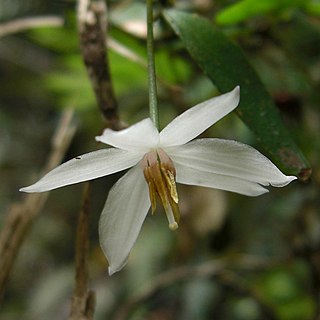
Luzuriaga radicans (quilineja) is a species of flowering plant in the genus Luzuriaga of the family Alstroemeriaceae (Inca-lilies), part of the monocot order Liliales.


















